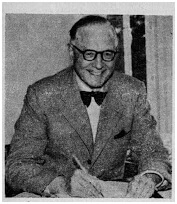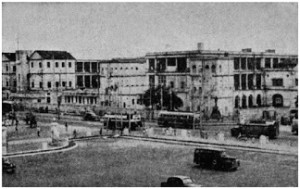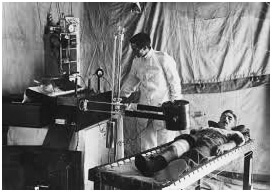Registered with the Registrar of Newspapers for India under R.N.I 53640/91
Vol. XXIX No. 1, April 16-30, 2019
The X-ray man at Madras
by Manmadhan Ullathil – from Maddy’s Ramblings

Dr. Christian Barnard.
Perhaps Dr. Christian Barnard’s blazing trail with his work on open heart surgery during the late 60s eclipsed the valuable contributions of another, the Captain Thomas William Barnard (TWB), O.B.E., F.H.A., F.R.P.S., M.S.R. who refined X-Ray techniques some three decades earlier, during his tenure at Madras. That he made a world standard institution of it at Madras would not be known to many and so I thought it a good idea to share some of TWB’s experiences and his charming insights with you all.
Prof Arcot Gajaraj wrote – “Captain Barnard belonged to the category of great men who had a modest beginning, but by dint of hard work, perseverance and foresight brought laurels not only on themselves but also made valuable contributions to the welfare of mankind. He was not a product of any medical school and began his life as an ordinary X-ray operator hardly 10 years after the very discovery of X-rays.” What is even more astounding, as our esteemed Madras Chronicler S. Muthiah explained, is the fact that Radiology came to Madras in 1900, when the General Hospital got an X-ray unit a mere five years after Wilhelm Roentgen’s discovery and before such facilities, it is claimed, were established in much of Europe and the rest of the world. As time went by and the first world war wrought tribulations on much of the western world, this invention was to bring about rapid developments in correct diagnosis of diseases, orthopedic issues and go on to impact medical sciences immensely. Let’s now trace the voyage of both man and equipment, their chance meeting at Bombay and see how it impacted the history of Indian medicine.

General Hospital as seen in early days.
But before we get to Barnard and his X-ray work, we should hasten to find out how the first X-ray unit reached Madras so early. It appears to have been installed during the days when senior surgeon and Professor Lt Col John Maitland served at the GH. We are given to understand that it was a primitive unit, run from a small set of accumulators. The radiologist who handled the equipment did not quite remain upto date with technology and was not well regarded, so avenues for private investment were opened and Dr. P. Rama Rao filled the void and set up his own X-ray institute at Kilpauk. One could conclude that Rama Rao and the unit at the GH, managed various patients of the Madras presidency, with Rao sharing a larger percentage of the clientele. As the anxiety of the Asst Surgeon General Dr Govindarajalu Naidu peaked with this deplorable state of affairs, he started a search for a qualified and experienced radiographer.
Captain Barnard’s entry into this dangerous field was deliberate. Why dangerous, you who have been under an X-ray machine so many times, would ask! In those days, the apparatus to produce these all-seeing rays was quite crude compared with that now used. It consisted of induction coils with various types of interrupters and many gadgets and devices and well, the naked X-ray Tube had to be kept cool by various means. Earlier machines were single phase self-rectified x-ray machines with air-cooled rectified valves, cones and cylinders. The tables were mechanically or manually operated with crude spot film devices, etc. There was but little protection against Radiation and Electrical dangers and the risks “X-ray operators” (as the staff were named in those days) were called upon to incur were many. Most of the early operators lost limbs and developed dermatitis and other related injuries.
T. W. Barnard joined the staff of the X-ray department of the London Hospital, Whitechapel in 1908. One aspect he picked up quite early was that even with poor equipment, one could obtain good results by dint of hard work. Quoting TWB from his memoirs “Although I used ‘naked’ X-ray Tubes with no protective shield, I escaped serious injury apart from damaged finger nails, as I took precautions ignored by my Seniors, the most important being to keep a safe distance from the X-ray Tube when it was in action; I attribute the fact that I am alive today being due to my use of a length of insulated flex by means of which I switched the Tube mounted on my Ward apparatus “on and of’ from a distance of about 10 feet”! Now you should also note that it was not a quick flash like you see today, but the patient was subjected to prolonged exposure for over 15 minutes to get a good image, so it was indeed a lot of radiation!

The X-ray procedure during Dr. Barnard’s time.
When the WWI started in 1914, there was a great demand for X-ray operators and initially TWB was not allowed to go to the war fronts but had to stay on at the ‘London’ hospital. It was in 1916 that he was deputed to the Cumbala hospital in Bombay. Reaching there he found no X ray unit to work with but just a leaky room filled with a number of packing cases. How those cases reached there is another interesting story, which I pieced together from diverse sources. If you recall, one of the fiercest losing conflicts fought by the British was with Mustafa Kemal’s Turkish army at Gallipoli, which left so many Australians, Brits and Indians dead. There had been virtually no x-ray service in the Dardanelles, and its lack was keenly felt. Mudros was the only medical facility on the Island of Lemnos which possessed an x-ray machine, and this had to serve one Indian and three British hospitals as well as meet its own needs. When the British retreated finally, this X-ray unit which had provided yeoman service to these soldiers, was packed up (hurriedly) and sent off to Bombay.
A friendly electrician and the ‘mad sahib’ TWB decided to install and commission this condemned system from Gallipoli, having been served at the war front. As the story goes, when powered on, the top of the gas tube promptly blew up due to moisture ingress. After scouring the Bombay bazaars for repair material, the duo patched it all up and after finding a willing patient, powered the system again only to see sparks flying all around the bewildered and terrified patient, who promptly fled.
It was from these humble beginnings in Bombay that TWB learnt so many important lessons such as cooling the film bed which usually could not withstand the X-ray heat or earthing the system (an invention wholly his, but something he never bothered to patent) to drain leakage currents. After moving to a hospital at Colaba and authoring a few papers, he found himself appointed as ‘Radiologist to the Government of Madras’. Barnard was enthusiastic because, as he stated – Madras has always had a good reputation for its Medical facilities and its high standard of Medical Education (I must add, my late father Dr Viswanatha Menon was a Stanley Medical College Alumni from the 50s and would have warmed to this statement!). By then, there was another X-ray unit in Tanjore and a second private clinic in Madras. Would you believe that the prime mover of the generator powering the Tanjore unit was run by a bullock trotting around?
Anyway, Dr TWB quickly got the new department (not the bullock) into a gallop and he was to remain there until 1941 as Chief Officer of Radiology Services with supervision of all X-ray services covering an area three times that of England and a population of 50 million. During that period Captain Barnard opened some twenty new X-ray departments in the state and developed the services in the Madras General Hospital and Medical College as a major teaching centre for South India. T.W.B. then established the Madras Government Institute of Radiology, which to his surprise was named after him on the day of the official opening in March 1934 as the Barnard Institute of Radiology. The centre had a primary GE-supplied Victor XP4 X-ray unit and a secondary screener unit and it became a major centre in South India with the initial cost of this section contributed by Dewan Bahadur M.R. Subbiah Chettiar.
Barnard, who continued as Director of the Institute till 1940, used the 400KV X-ray unit installed in 1934 for the first time in India on his wife’s hand, just as Roentgen had done the first X-ray ever on his wife’s hand!
(To be concluded next fortnight)

